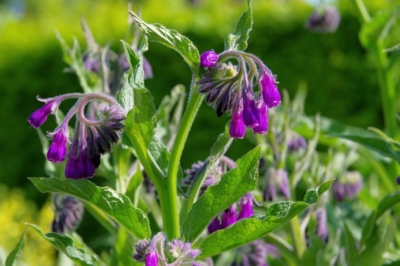As a herb from the family of roughleaf plants, comfrey is native to this country. For this reason, it is undemanding and can be grown in the garden without any problems.

Contents
What are the site requirements comfrey?
Bright and warm it should be, then comfrey feels good. Semi-shaded locations in a sheltered position are best. Also suitable are places with full sun. Comfrey does not like to grow in deep shade.
Comfrey is considered a moisture-loving plant. It likes medium to heavy soils with a high moisture content. Other preferences in terms of substrate are:
- pH between 6.5 and 7.5
- high nutrient content
- medium to high humus content
- loose and well-drained texture
Which plant neighbors are suitable?
Since comfrey copes excellently with heavy, loamy to clayey and moist soils, it should – if it is not to stand alone – be planted in the neighborhood with plants that also like such a subsoil. These include, for example, wormwood, elecampane and lovage. But be careful: when planting, keep a planting distance of at least 1 meter!
What is the recommended time for planting?
Comfrey is hardy and can survive with its roots in its location for up to 20 years. It can be planted in the open ground all year round in pre-cultivated form. But it is recommended to plant it between April and May.
How can comfrey be propagated?
Comfrey can be easily propagated through its seeds. These can be sown directly in the open ground in April. They can be grown in advance on the windowsill starting in March. As a rule, you have to wait about 2 weeks before the first beginnings of a plant appear.
Alternatively, comfrey can be propagated through its roots. Dig up a piece of root from an existing comfrey plant. Plant this in a different location. If it is warm enough, a new plant will soon appear.
Tips & Tricks
Once planted, comfrey will reappear every year without much intervention. The leaves can be cut off regularly and used to make manure.

